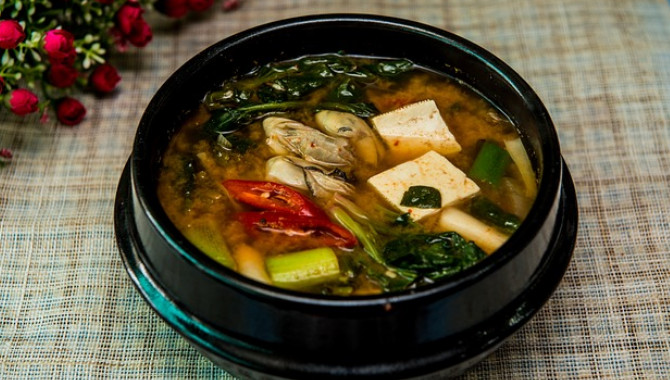A growing number of people are making the decision to go vegan, due to concerns about the environment, moral issues with the consumption of animal products, or even desire to eat more healthily. If you have recently adopted the vegan lifestyle, it can sometimes be daunting trying to work out whether or not you can eat certain foods and although it gets much easier over time, I do still need to check from time to time. A recent example for me was miso soup; a high-protein traditional Japanese soup, which is made using a stock and miso paste.
So is miso soup vegan? If it is bought from a traditional restaurant, the answer will often be no. Although a number of different stocks can be used, the ones that are most common in authentic Japanese restaurants are fish-based and, therefore, off-limits to vegans. However, there are exceptions.
The good news is that some restaurants will use a vegan-friendly stock instead, especially in western countries. However, there are other ingredients you may also need to look out for, making the process of finding vegan-friendly miso soup slightly more complicated. Of course, it is also perfectly possible to make homemade vegan miso soup as well, by switching the stock out for a vegan replacement. In this article, I will outline what miso soup is, why it is often unsuitable for vegans, the main ingredients to look out for, and how you can make a homemade vegan miso soup.
The Core Ingredients of Miso Soup
Miso soup is a traditional Japanese soup, which is made by combining miso paste with a “dashi”, which is a type of soup stock. It is one of the two most popular types of soup from Japan and is known for its high protein content, as well as the various vitamins and minerals it contains, making it an extremely healthy dish.
Miso itself is sometimes referred to as soybean paste and is typically created by fermenting soybeans with a fungus called koji, along with salt or another seasoning. Additional ingredients, such as rice, seaweed and barley may also be used. This then results in the creation of a paste, which forms the basis for miso soup. Any additional ingredients may be cooked in the stock, or “dashi”. The paste is then mixed into the stock too, creating the soup.
At this point, you may be noticing that the core ingredients for the dish are all either vegan-friendly, such as soybeans, rice, seaweed and barley, or potentially vegan-friendly, as is the case with the stock. I should, therefore, stress that miso soup can be vegan and this can be achieved without making any real alterations to the recipe. The problem comes when you are buying traditional Japanese miso soup, especially from a Japanese restaurant, but even in “instant soup” packets. This is due to the type of stock that is most commonly used during the soup’s preparation.
In most cases however, a traditional miso soup will be prepared using a fish-based stock. One of the most common examples is katsuobushi dashi, which is made from a combination of tuna, water and dried kelp. A popular alternative is niboshi dashi, which is made using baby sardines instead of tuna. There are some traditional stocks that are vegan-friendly, including hoshi-shiitake dashi, which uses dried shiitake mushrooms, and kombu dashi, made from kelp and water, without the fish. Unfortunately, these are much less common than the fish-based stocks.
When prepared in western countries, using less traditional methods, different stocks may be used. This can occur with miso soup that is served in restaurants, but also with miso soup that is sold pre-made in shops, as a ready meal. However, even here, caution is needed for vegans, because it is common for the Japanese fish-based stocks to be replaced with chicken-based stocks, which are equally unsuitable.
All of this means that miso soup can be vegan, but will often not be, especially if it is cooked in the traditional style. Certainly, you should never assume miso soup is vegan. If you are in a restaurant, my advice would be to ask whether or not the soup is suitable for vegans before ordering, unless the menu specifically states that it is vegan-friendly. You should avoid making your judgement purely from the ingredients listed on the menu, as they may not mention the fish stock. If you are buying from a shop, check the ingredients list carefully, or look for a certified vegan product.
Other Common Miso Soup Ingredients
While the core ingredients of a basic miso soup can either be vegan or not, based on the type of stock that is used, the search for a vegan miso soup can also be further complicated by the fact that additional solid ingredients are often added to the soup to provide it with more flavour and substance. This means that even if you do source a miso soup that uses a vegan-friendly stock, there is still the possibility that it is not actually vegan.
Some of the most common examples of solid ingredients that are added to miso soup include tofu, onions, mushrooms and seaweed, all of which are vegan-friendly. Potatoes are another popular ingredient and these are almost always vegan-friendly too. However, in the absence of clarity, I would recommend that you double check that they have not come into contact with butter at any point, or either been cooked or preserved using an animal fat, such as duck fat.
Meanwhile, some of the solid ingredients that are commonly added to miso soup make it much more obviously off-limits to vegans. These include fish and other seafood, such as prawn or shrimp; poultry, such as chicken or turkey; and other meats, including pork or beef. In many cases, the miso soup will be served with noodles, so it is also imperative that you check whether these are vegan. Some Japanese noodles contain either egg or egg powder, while many packaged noodles from shops are made in factories where cross-contamination with egg is possible.
Again, the best course of action is to ask the restaurant whether or not the miso soup is actually vegan, rather than simply reading the ingredients from the menu. If you are buying from a supermarket or local shop, check the label and, if at all possible, opt for one with a clearly visible vegan-friendly label to remove all doubt.
Making Your Own Vegan Miso Soup
A number of brands sell vegan-friendly miso soup and miso soup kits, including Miso Tasty, Itsu and Clearspring. However, another way to guarantee that the miso soup you are eating is suitable for vegans is to make it yourself at home. This is actually a lot easier than you might expect. I have outlined the basic steps that you will need to take below. However, the precise ingredients you use will depend on the type of miso soup you want to make.
The first step is to prepare and cook any of the solid ingredients you are intending to add to the soup, such as onions or mushrooms. If you are not intending to add any solid ingredients, you can skip this step. You will also need to start preparing anything you are serving alongside the dish, such as noodles or rice.
Next, add the miso paste to the solid ingredients you have cooked, along with a small amount of whichever vegan-friendly stock you have opted for. In my experience, vegetable stock works best. Wait for the miso paste to turn into a liquid and then add the remainder of the stock. Stir the mix and allow it to simmer gently.
At this point, you can start to add any of the solid ingredients that either do not need to be cooked, or that require only a small amount of cooking, with tofu being the most common example. Cook for a few more minutes, stirring the soup as you do so. Once everything is in the pot and the miso soup is sufficiently hot, it should be ready to serve. Either pour it into a bowl, pour it over your noodles, or eat it straight from the pot. It is best to eat miso soup as soon as it becomes cool enough to do so, rather than leaving it to cool down for a prolonged amount of time.
Why is it Important to Avoid Fish Stock?
To be clear, the main thing getting in the way of us vegans eating miso soup is the potential use of a fish-based stock. In traditional Japanese cooking, fish stock is usually made by cooking skipjack tuna flakes in boiling water. In the west, fish-based stocks are sometimes made using either fish heads, fish bones, or a combination of the two. Quite clearly, these are not in-keeping with a vegan diet, due to the use of animal products. However, if you are new to a vegan diet, or considering adopting the lifestyle, you may be wondering what the big deal is with the use of fish-based products.
This is understandable, due to widespread misinformation that has been spread over decades. Some of the myths that are often repeated include the idea that fish do not feel pain and the idea that fish are caught in the wild, which means eating fish does not contribute to environmental problems in the same way that industrial-scale farming of livestock does. In reality, these myths are not only wrong, but perpetuating them can be extremely damaging.
Research shows that fish have a nervous system, complete with pain receptors. As a result, they experience the feeling of pain, just like any other animal. Meanwhile, the fishing industry uses a range of extremely damaging fishing practices, including bottom-trawling and the use of dynamite, which are damaging the sea floor and our ecosystem, while contributing to the overall destruction of the planet itself. Over-fishing has had a devastating impact on the number of fish left in our oceans, while farmed fish are often caged and kept in terrible conditions.
On top of all this, our efforts in depleting the number of fish in the oceans have also had a detrimental impact on other sea life. In truth, if you are still wondering why to become vegan, the fishing industry alone provides ample reason.
Welcome to VeganClue - My name is Robert Van De Ville and together with my team we spent hundreds of hours researching the most relevant topics for Vegans and non yet Vegans. Are you looking for more information about Veganism, animal welfare, diet, health, and environmental benefits of the Vegan lifestyle? You are in the right place! Enjoy the site.

